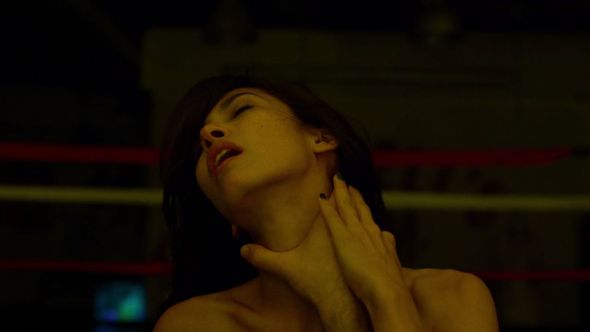In the Netflix Daredevil series, Matt Murdock first meets Elektra when he’s crashing a faculty party. He walks across a crowded floor in search of booze, as his progress is intercut with glimpses of Elektra: her expensive bracelets, her lips on a wineglass. The back and forth between his face and the bits of her suggests we are seeing her through him, his gaze creating an erotic, impressionistic, portrait: sex as vivisection.
The director of the episode, I believe, is Floria Sigismondi, but even though she’s a woman, the framing here is a perfect encapsulation of Laura Mulvey’s male gaze tropes. Mulvey argued that women onscreen are turned into individual body parts, which then freeze the narrative in fetishistic contemplation. Elektra, as body, interrupts Matt’s progress; she is framed through his gaze, even as she immobilizes that gaze.
The caveat here is that there is no gaze; Matt is blind; he can’t see Elektra.
You might think Matt’s blindness would undermine the male gaze. But instead it perfects it. His super-senses are more male gaze than the male gaze itself. His hearing, his smell, mean that he does not see her all at once, as a person, but rather as bits and pieces. Through his blindness, he knows her and possesses her more completely than if he were sighted—as he demonstrates at the scenes end, when he gets the better of her in a battle of wits, and leaves with her, future intercourse heavily telegraphed.
Ever Oedipus and/or Freud blindness has been associated with castration. Daredevil’s disability carries with it the threat of unmanliness. One could, perhaps, imagine a Daredevil series which thought through that stereotype, and which thought about the ways that disability questions the necessity, or the righteousness, or the centrality, of strength, competence, virility.
That’s not the Daredevil series we’ve got though. Instead, Elektra is aroused and excited when she learns that Matt isn’t really blind. She wants a man who can fight her, and whose disability is only a show. Matt, for his part, is thrilled that she has found out his secret; he babbles about how she really “knows” him, which means in part that she knows he’s not actually disabled. The two eventually fall out over whether Matt should murder (Elektra feels he should) but her obvious contempt for his disability is never an issue. As far as the show is concerned, it’s natural for Elektra to prefer a sighted man to a blind one, and Matt (who is blind) is pleased that she does.
Similarly, Matt’s ability to sense Elektra, and to frame her in his gaze which is not a gaze, works as a deliberate assertion that he is not castrated. His disability is filmed in such a way that it makes him fit even more firmly into the tropes of manliness. The most striking thing about the Daredevil series is its utter disinterest in ever giving us a Daredevil-eye view of the world; we do not experience the world as Daredevil does. Instead, Daredevil’s vision is the traditional vision of film. Blind men, the film assures us eagerly, see with the same manly eyes as ever.


Great breakdown, Noah. What do you make of the fact that few of the comics show a “Daredevil-eye’s view of the world”?
Frank Miller said of Daredevil that he’s the sexiest of all the superheroes, and I think your analysis sufficiently explores that in how he meant, albeit with an ultimately different takeaway. Daredevil as a character is a womanizer, so the use of the male gaze makes sense in this way.
Sean, I don’t know that I’ve read enough Daredevil comics to comment on that globally. Frank Miller/Mazzucchelli did some Daredevil-eye view of the world I believe, which were interesting (mostly outlines suggesting sonar.) There’s the scene in born again where Daredevil is trying to drive in the rain, which screws with his sonar and has bad results. I haven’t seen anything like that in the series yet…except I guess he gets shot in the head and then has some problems controlling his senses. But that’s about him being less than at full strength, rather than thinking about how living with disability day to day might work.
In the recent go-round, by Paolo Rivera, Marcos Martin, Chris Samnee, Mark Waid et al., there’ve been some more creative depictions of how the world sees to him, and of his superpowers in general. Most strikingly, this cover to the first issue, by Paolo Rivera.
What I’ve read of the series is actually pretty good for a superhero series. And unlike most times when people say “it’s actually pretty good for a superhero series”, it really is.
I will say that as a young gay (but not out) teenager, what drew me to read my brother’s set of Miller’s Daredevil comics was partly how sexy Daredevil visually came across in them. That said, my memories are Elektra was objectified more. But it felt pretty even to me. Something I can’t say about later Miller works (I know he only did the basic layouts for a lot of that Daredevil run, but). And yes I am will fully ignoring Miller’s work on 300.